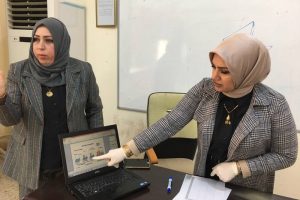
Ferroelectric Ferromagnetic composite materials
Physics Department at the College of Science – University of Diyala, discussed the thesis masters student (Ali Ahmed Hassan) entitled (Ferroelectric Ferromagnetic composite materials) on (Wednesday) (2017/5/10) in the Discussions Hall at the Deanship of the College of Science.
In the present study, BaTiO3+CuFe2O4 composite materials were synthesized using sol-gel auto combustion chemical method, in which pre-synthesized Barium Titanate was combined with the copper ferrite, using Titanium oxide, Barium nitrate, Ferric nitrate nine hydrate, Citric acid, Copper nitrate Tri hydrate and ammonium solution. BaTiO3 was born on (800◦C) for 3hour then it out the oven and mixing in strung again, put in crucible and burned at 1200◦C and cooled at room temperature. CuFe2O4 was burned in (200-220◦C) and cooled at room temperature, Then Calcine at (400°C) for three hours. This process was repeated to obtain ferrimagnetic and ferroelectric composites [xBaTiO3+(1-x)CuFe2O4] with different weight fractions (x= 0, 0.1, 0.2, 0.3, 0.4, 0.5, 0.6, 0.7, 0.8, 0.9, 1) .Then composite powders with different weight, burn each mix at 800◦C for three hours. Then composite powder with different weight percent were milled and pressed into pellets 1.2cm, and then darken at 950◦C for three hours.
The Structural, electrical and dielectric properties of BaTiO3+CuFe2O4 composite materials nanopowders have been studied using FTIR, XRD, AFM, SEM and LCR-meter analysis.
FTIR-spectra of BaTiO3+CuFe2O4 composite materials powders calcined at deferent temperatures (950◦C) Where shown Fourier transform infrared model barium titanate nanoparticles prepared having packets within the scope of the (522 cm -1) to (547 cm -1) belonging to the Association of Aoxgen- metal (titanium), it featured packages within the scope of the (459 cm -1) to ( 584 cm -1) belonging to the Association of oxygen – a metal (copper), as well as packages have emerged within the range (550-600 and 400-450cm-1) belonging to the Association of oxygen – a metal (titanium – copper).
The chemical phase analysis that has been used X-ray diffraction measurement device XRD confirms be copper ferrite (CuFe2O4 spinel powder), Barium Titanate (Barovskait) and materials overlapped between them. Where the study of X-ray diffraction showed that the crystal size increases with increasing temperature calcination powder (copper ferrite). While finding that the crystal size increases with the concentration of Barium Titanate decrease concentration (copper ferrite) and also found that the lattice constant decreases (at least) with the increase concentration Barium Titanate. The theoretical ferrite powder density decreases with increase Barium Titanate content.
From SEM micrographs, cobalt ferrite show that the particle size is less than 100nm, also noted an increase in the particle shapes with increasing calcination temperatures. AFM figures proved that the particle size is very small, homogeneous and in the range of nano size.
Electric and dielectric properties were studied in all pelletized and sintered samples at temperature 9500C, and the frequency range of (50 Hz – 5MHz).
AC Resistivity of all samples (sintered at 9500C) have been measured as a function of frequency and found it decreases with increase in frequency. Dielectric constant (εr'), the loss tangent ( tanδ ) and the loss factor (εr′′) are calculated from capacitance data, and showed that the dielectric parameters decreases with increasing frequency. This behavior is typical of ferrites as explained by Koop’s model, Conductivity increased with increase Barium Titanate content in BaTiO3+CuFe2O4 composite materials, dielectric loss were change between increase and decrease with increase Barium Titanate, while conductivity increases with frequency increase.
The message was acceptance and earned the student a master's degree in solid state physics and materials.





